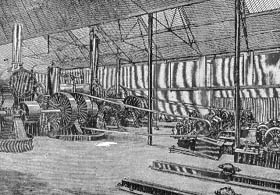
Brighton power plant -1887 -
 Deptford power plant - 1889 -
Deptford power plant - 1889 -
The electric current "induced" by magnetism is called dynamic-electric and generators are (sometimes) called dynamos. After first attempts the generators improved magnetic circuits till to replace the permanent magnets by induction coils.
The massive iron cores were abandoned and appeared the laminated iron cores to avoid eddy currents.
E.W.von Siemens (1816-1892) were one of most important man of this period. In december 1866 he presented at Science Accademie of Berlin a generator that produced current without using permanent magnets.
The first efficient generator was built by Zenobe Theophile Gramme (1826-1901) a belgian man who leaved in Paris. To avoid eddy currents the core of his machine was built using iron wire insulated with bitumen.
The dynamos of Gramme were used in lighthouses, in electroplating, for manufactory's illumination and were drived by steam engines.
The Gare du Nord in Paris was illuminated by arc-lamp in 1857. In 1878 was illuminated by elecric lamps the Gaiety Theatre in London. The houses couldn't be illuminated by electricity, also the more little arc-lamps were too powerful.
Only after the first filament-lamp invented by Swan the electricity demand increased.
Was better the direct current or the alternating current ?
Using direct current was possible to charge a large battery during the periods of low demand to use in the peak periods.
Was general opinion the the alternating current was more dangerous than the direct current (electric chair introduced in this period used alternating current).
In favour of the direct current were Edison and Lord Kelvin, for the alternating current were Westinghouse, Tesla and Ferranti.
As result of those debates were built power plants of the two types which took inconveniences to the electricity consumers.
The electric production was standardized after world war II.In 1880 all were persuaded that the electric current had great possibilities (as energy for manufactories and for private houses).
Was more convenient to produce electricity in many little power plants or in a small number of great power plants ? The first power plant was the Holborn Viaduct of Edison Company that began to work in 1882. It was built for streets lighting and after was used also for private houses.
In this picture is showed the Brighton power plant of 1887. It produced alternating current at hight tension and each consumer had a transformer.
The generators was drived by steam engines.
In 1887 was established the London Electricity Supply Corporation to build a very big power plant in Deptford to serve a large area of London.
Works manager was Sebastian Ziani de Ferranti (1824-1907) who was one of the few upholder of hight tension transmission.
The Deptford power plant was built with two Ferranti's alternators at 5.000 volt drived by two steam engines of 1.250 HP.
The first attempt to transmit electricity at 10.000 volt gave problems and Ferranti projected a new cable with concentric conductors insulated by pressed paper which became in general use.
The Deptford power plant was opened in 1889 but worked at full strenght only in 1891. The transmission at 10.000 volt gave good results.
This power plant can to be considered the founder of the large power plants family.